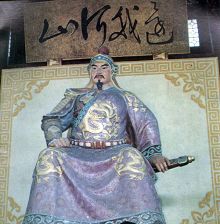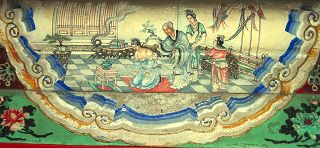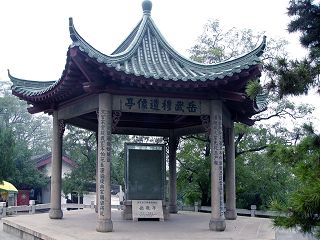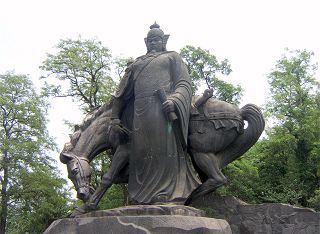Stories from History: Yue Fei and Wuhan (Part 1)
(Clearwisdom.net)
Statue of Yue Fei in Yue Fei Temple
Yue Fei lived from the years 1103-1141. He was born in Tangyin County of Xiangzhou, now a part of China's Henan Province. Yue Fei is well remembered in Chinese history as a great general and national hero of the Southern Song Dynasty.
Yue Fei was a diligent student. He developed good skills in the martial arts and joined the army at the age of 19. Shortly afterwards, his father passed away, so Yue Fei left the army to go home and mourn his father.
In 1126, the Jin Dynasty invaded the Southern Song Dynasty. Yue Fei joined the army again and thus resumed his military career to defend the country. Living by the principle to “serve the country with utmost loyalty” he carried out the mission to take back the land that was occupied by the Jin invaders. His army was well trained with strong discipline and “would rather die of hunger than rob people, and die of cold than tear people's houses down to burn.” Yue Fei's army continuously defeated the Jin army and were well liked by the people.
In his military career, Yue Fei directed 126 battles and didn't even lose a single one. He is a true “forever-victorious general.” Jin's army was so afraid of Yue Fei's army that they said, “To shake the mountains is easy, but to shake Yue Fei's army is barely possible.”
Yue Fei's mother writes “Jing Zhong Bao Guo” or “served the country with utmost loyalty” on his back, as depicted in a decoration on a beam at the Summer Palace, Beijing.
According to history, Yue Fei's mother, Mrs. Yao, died at his military base in Ezhou (in Hubei Province) in March 1136. Deciding to resign his official position, Yue Fei left without reporting to the emperor. He carried her coffin to Lu Mountain, Jiangxi Province and submitted a report to request approval to stay in mourning for his mother. But the emperor ordered him to come back to serve the country. So Yue Fei “converted his filial piety to loyalty (to the emperor and the country)” and returned to his position.
Yue Fei exhibited honesty and high moral standards when taking official positions. He often said, “If officials do not like money and generals do not fear death, the world will be in peace.”
Being a general, Yue Fei liked reading Zuo Zhuan, a history book about the Spring and Autumn Period (722 BC – 468 BC) and military books by Sun Tzu, etc. During the break times between battles, he also wrote and read poems with his staff. Fourteen of his poems and three ci have been passed down, among them, “Man Jiang Hong” demonstrates his strong patriotism and determination to defend his country.
Yue Fei also enjoyed calligraphy. His writing of regular script in small characters followed Yan Zhenqing's (a leading calligrapher in China) style while his running-regular script followed Su Shi's (another famous calligrapher) style. Several of his stone inscriptions still exist. The “First and Second Memorials on Dispatching the Troops” was the most famous one.
The main historical sites in Wuhan that are related to Yue Fei are:
Yue Fei Pavilion
The Yue Fei Pavilion is located in front of the Yue Fei Bronze Statue in Huanghe Park. It faces south and was built in 1937 and renovated in 1981. It was built with stone and wood and has hexagonal tips pointing up to the sky and green glazed roof tiles. The whole construction is simple and dignified.
The stone stele of Yue Fei's picture (it was said to be from the Valiant Temple of Prince of E located outside the Big East Gate in Wuchang) is inside the pavilion.
Yue Fei Bronze Statue
岳飞铜像
“Return My River and Mountains” (Yue Fei's calligraphic writing)
《还我河山》
The bronze statue of Yue Fei is eight meters (27 feet) high. It sits on a two-meter base. It depicts Yue Fei holding the reins of the horse, exhibiting valiant demeanor, righteousness, and a powerful stare, as if looking at the rivers and mountains of the country. A 25.6 meter (85 feet) wide blue stone relief depicts the scene of his army defeating Jin's army. His ci (a type of poem) “Man Jiang Hong – Thoughts after Climbing the Huanghe Tower” was engraved on it. The whole sculpture is powerful and smooth, and evokes a shocking effect on people.
After the Japanese invaded Beijing in 1937, Wuhan's anti-Japanese groups found a green stele that was from the Tenth Year of Wanli Period in the Ming Dynasty (1582). The stele had Yue Fei's picture and an eulogy poem by Zhang Yixian from Dali City, Yunnan Province. Several groups selected Hu Zhi, a member of the Xinhai Revolution Club, to lead the effort to collect money and build the Pavilion of Yue Fei's Picture of eight meters east of the temple. The stele was erected inside the pavilion. The pavilion thus became famous due to the stele.
(To be continued)




